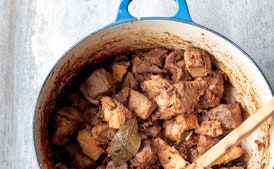
Introduction
Carnitas is a classic Mexican dish that transforms tough cuts of pork into tender, flavorful delicacies. Originating from the Pueblan region of Mexico, this technique has evolved over time to include diverse cooking methods and ingredients, yet remains true to its roots in celebration and family gatherings.
Tips for This Recipe
When making Carnitas with an Electric Pressure Cooker, ensure all pieces of pork are uniform in size for even cooking. For the braising process, use a heavy-bottomed pan to maintain low and consistent heat. The frying stage should be done quickly to avoid overcooking while achieving that signature crispy exterior.
Why You Will Love This Recipe
Carnitas is not just about the delectable pork; it’s a dish full of warmth and tradition, perfect for sharing with loved ones. The depth of flavor from braising followed by frying creates tender meat that falls off the bone, making each bite an irresistible experience.
Ingredients
4 pounds fatty pork shoulder, cut into 2-inch pieces
3 cups water
1 medium white onion, thinly sliced
1/2 orange, cut into 2 pieces
1/4 cup pork lard or vegetable oil
8 garlic cloves, peeled
3 bay leaves
1 tablespoon sweetened condensed milk
2 teaspoons dried oregano, preferably Mexican, crumbled
2 teaspoons fine salt, or 4 teaspoons kosher salt
Adviced Equipments
Electric Pressure Cooker
Non-stick Frying Pan
Large Stock Pot
Meat Thermometer
Dutch Oven or Heavy Pot
Mandoline Slicer
Heatproof Silicone Gloves
Wooden Spoon or Tongs
Food Processor with Slicing Blade
Silicone Spatula
Measuring Cups and Spoons Set
Food Storage Containers
History of the Recipe
Carnitas’ roots are deeply embedded in Mexican cuisine, particularly from Puebla. Traditionally cooked over an open flame for hours on a barbecue pit known as a “hornos,” it has evolved with modern kitchens. The technique of braising and frying pork has made Carnitas accessible and delicious beyond its origins, symbolizing the adaptability and resilience of Mexican culinary traditions.
Fun Facts About This Recipe
1. While often associated with street food in Mexico, Carnitas can be served at home as a heartwarming centerpiece for family meals or celebrations.
2. The dish’s name is derived from the Spanish word “cárnica,” which means “meat.” It showcases how culinary terms often cross cultural boundaries and become part of local vernacular.
3. Carnitas can be versatile, pairing beautifully with a variety of sides like tortillas, rice, and beans, or topping tacos and burritos for an authentic flavor explosion. This dish not only nourishes the body but also feeds the soul, connecting generations through its rich history and mouthwatering taste.



